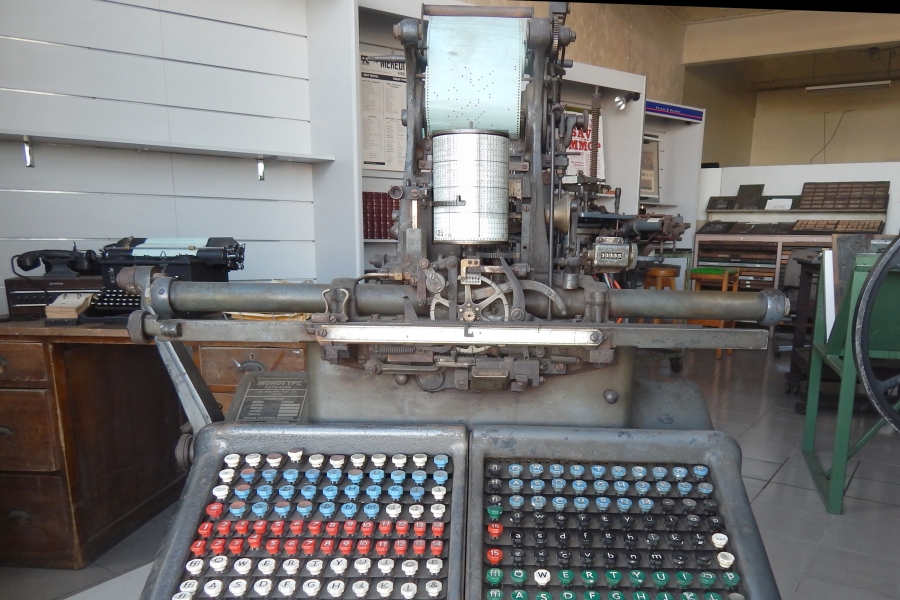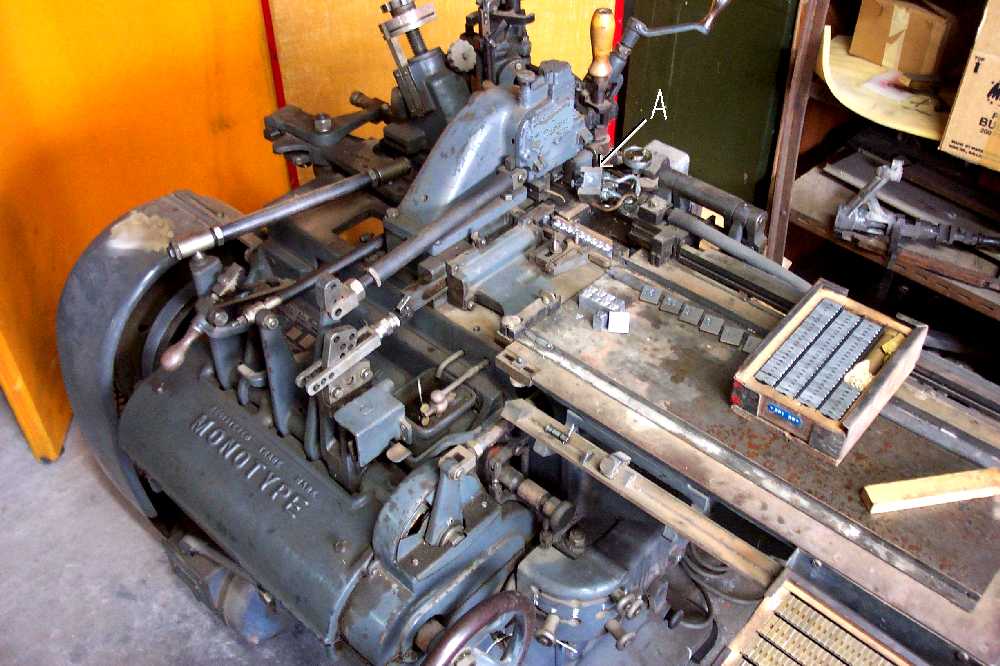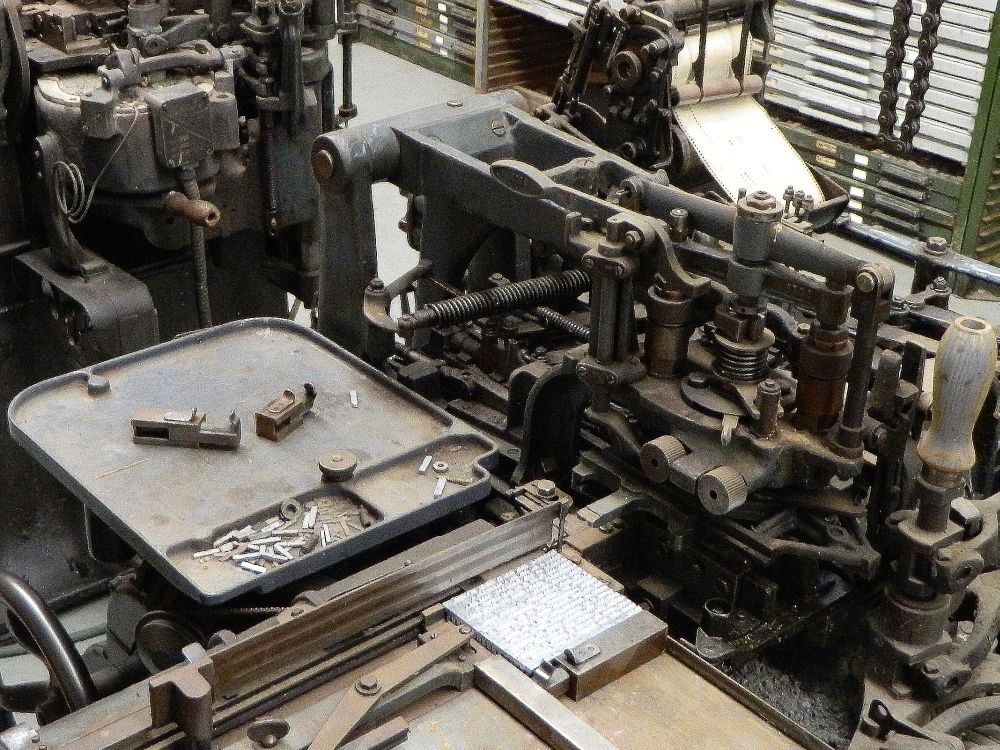|
Movable type composed by hand began to be superseded by mechanical
typesetting from around 1890. Mergenthaler's linecaster and Rogers' Typograph
led the way, and Lanston's Composition Typecaster quickly followed.
Mergenthaler's machine produces each line as a solid piece, "a line of type"
and it came to be called the "Linotype". Rogers' machine, also a linecaster,
was successful in its own way but was withdrawn from the market when Mergenthaler
bought the company from Mr. Rogers.
Tolbert Lanston's machine does not cast solid lines: it casts individual
types and the name Monotype helped distinguish it from the linecasters.
There were by that time a range of machines that would automatically cast
individual types but not compose. They would make movable types in bulk for
later setting by hand. But Lanston's system (two separate machines) had
a keyboard and it would make types in the required order to compose a text.

The Monotype Keyboard (seen here in the Showroom) is a separate machine from the Monotype Composition
Caster. The keyboard machine, operated by compressed air, punches the code-holes
into the 31-channel paper tape in response to taps on the various keys.
WARNING ! COMPLEX PARAGRAPHS FOLLOW.
As it does so it keeps track of the total width of the letters and spaces
in the line so it can know the space remaining in the line when the last letter
has been tapped. It can then divide that remaining space by the number of word
spaces to find the extra width that must be added to each word-space in the line in
order to exactly fill that line to the "measure" that applies to that story,
and that information is coded onto the tape.
The tape is then, or later, mounted onto the air-tower of the Monotype
Composition Caster. The air-tower reads the holes in the tape and controls
the operation of the caster.
The caster is set up by its attendant for each job. The set-up includes the
correct matrix-case and sizing-wedge for the typeface and size, the correct mould
for the size, the exact width ("measure") of the job, and any special characters
required (e.g. asterisk, percent, degree, accented letters, fractions).
The caster is capable of making three types per second but this speed is
only possible for very small typefaces because of the heat-load.
For each character, the caster reads the next frame of the tape, positions
the matrix case so that the matrix required for that character is located
over the mould aperture, adjusts, according to the sizing-wedge, the set-width of
the aperture to the width required for that character, raises the pump and nozzle
to form a metal-tight mating with the underside of the mould, discharges the pump
to fill the mould with molten metal, waits about 50 milli-seconds for the metal
to freeze, pushes the cross-block away from the aperture and brings the type
carrier to that position.
It then fully closes the type-mould blade to eject the newly-formed type into
the carrier, brings the cross-block back and the carrier back to be level with the
type-channel, and pushes the type into the channel where it takes its place in
the growing line of text. At that moment, the machine is casting the following
type.
All that can be done in one-third of a second.
The mould is cooled by a flow of water, without which the hot metal being pumped
into it would overheat the mould and it would be damaged. The heat load with larger type
(such as 12 point) is much greater than for 6 point, and the machine must run slower
with those larger sizes.
 THE MONOTYPE SUPERCASTER AT WORK. A BOX OF MATRICES IS ON
THE TABLE OF THE MACHINE, AND A FEW HAVE BEEN PLACED ON THE TABLE. THE MATRIX HOLDER,
WITH A MATRIX IN IT, IS HIGHLIGHTED BY THE ARROW. A FEW NEW TYPES, JUST MADE, ARE
VISIBLE IN THE TYPE CHANNEL.
THE MONOTYPE SUPERCASTER AT WORK. A BOX OF MATRICES IS ON
THE TABLE OF THE MACHINE, AND A FEW HAVE BEEN PLACED ON THE TABLE. THE MATRIX HOLDER,
WITH A MATRIX IN IT, IS HIGHLIGHTED BY THE ARROW. A FEW NEW TYPES, JUST MADE, ARE
VISIBLE IN THE TYPE CHANNEL.
ON THE SHELF, BEHIND, IS A SPARE METAL PUMP: IN USE, THE BODY OF THE PUMP IS
SUBMERGED IN THE CRUCIBLE OF MOLTEN TYPEMETAL.
The Monotype Supercaster is not fully automatic. It is described as semi-automatic
as it needs its attendant to place the selected matrix into its holder and thence
into the space above the mould. The set-width required for each character also needs
to be set by the attendant, who would then start the machine and, usually, make a
quantity of each character before changing to the next one. These types would either
be made up into founts or laid into a typecase for hand composition.
The Supercaster most commonly produces type in sizes from 14 pt to 72 pt. If a user
did not have a composition caster, they could choose to use a Supercaster to make
smaller type (for hand setting) right down to 6 pt or less. The Supercaster has an
adaptation to produce other material such as strips of spacing and strips of
ornamental borders in any length.
.
.
.
| 

